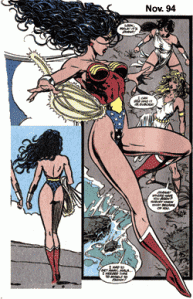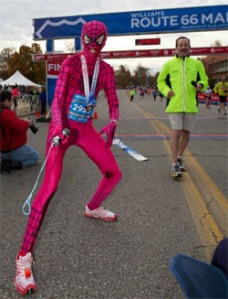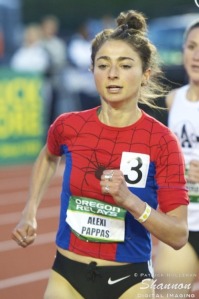“We just happen to show a little more skin when we get to the ladies,” says Image Comics artist Todd McFarlane, explaining that the portrayal of women as sex objects in comics is a natural byproduct of the genre’s generally exaggerated style. “As much as we stereotype the women, we also do it with the guys. They are all beautiful. So we actually stereotype both sexes.”
McFarlane was trying to plug the PBS documentary Superheroes: The Never Ending Battle (it starts October 8), but his comments, and those of Kick-Ass writer Mark Millar trivializing rape (“I don’t really think it matters. It’s the same as, like, a decapitation. It’s just a horrible act to show that somebody’s a bad guy”), pissed off plenty of fans. Garth Ennis combines the two approaches—rape and lady skin—in The Boys when his Superman stand-in Homelander compels newcomer Starlight to give him and his teammates blowjobs before taking a Sharpie to her costume and drawing in navel-deep cleavage: “New costume concept for you. They want something a bit more photogenic.”
McFarlane co-founded Image in the 90s, The Boys premiered in 2006, Kick-Ass in 2008, so that might be the problem. These Cro-Magnons are behind the times. Todd thinks he’s just obeying the testosterone-driven norms that give him no choice but to draw scantily clad, super-breasted, Barbie-legged uber-women. But if that’s true, why is the comic book population of anatomically impossible porn gals in decline?
A friend of mine, Carolyn Cocca, spent her summer staring at T&A. She studied 14,599 comic book panels, adding a checkmark to her tallies only if a particular tit or ass cheek “was just about to fall out.” She didn’t count mere cleavage or skintight curves unless they included a panel-dominating breast “larger than a woman’s head.” The results? “Female characters,” she reports, “were portrayed in more panels and less likely to be objectified in the early 2010s than they were in the mid-2000s or mid-1990s in the same titles.” Carolyn is also chair of Politics, Economics & Law at SUNY’s Old Westbury College, so her expertise in quantitative analysis is larger than Todd, Mark, and Garth’s breast-sized heads combined.
Professor Cocca’s not alone in critiquing the absurd poses male artist inflict on their female subjects. The internet is busting out with parodies of McFarland inhabitants:
Alexander Salazar asks what if male superheroes were drawn like female superheroes with some very bare-chested and shorts-bulging results.
Kelly Turnbull refashions the entire Justice League in Wonder Woman style.
Steve Niles has similar fun with the Avengers.
Multiple artists take aim at Hawkeye.
Michael Lee Lunsford dares the impossible by drawing superheroines fully clothed.
John Raptor’s “reality”-based superheroine includes “practical underwear” and “legs like tree trunks.”
Ami Angelwings’s Escher Girls documents a disturbing range of anatomical impossibilities.
The list goes on, and for good reason. Though Carolyn’s sample shows a decrease in objectification, practically all of the comics she looked at show at least some. “Had I counted each depiction of cleavage or of extraordinary shapeliness in spandex or of focus on clothed curves,” she explains, “this number would have been almost exactly the same as the number of panels depicting women.”
If you’re wondering how things got so far out of proportion, you need to travel back to the Dark Age of the late 80s. This was a primitive time, when the dictates of the Comics Code still ruled the multiverse. As far as “Costume,” it decreed “Females shall be drawn realistically without undue emphasis on any physical quality.” That’s what the Comics Authority had been saying since 1954, only with the phrase “undue emphasis on” swapping out “exaggeration of” in 1971. It wasn’t much of a reboot, which might explain why the 1989 revision stripped off so much more. Under the new heading “ATTIRE AND SEXUALITY,” the update declared: “Costumes in a comic book will be considered to be acceptable if they fall within the scope of contemporary styles and fashions.”
Doesn’t sound very revolutionary till you see Wonder Woman in a 1994 thong. In his defense, artist Mike Deodato Jr. said he preferred drawing monsters anyway.
The superheroine bikini cut deepened again in the 2000s as the Code teetered toward collapse. Marvel dropped it in 2001. Image never had it. Either way, we’re looking at plenty of T&A for Carolyn’s tally sheets during the two decade range. Arguably, this was the multiverse before the cleavage-confining Code trussed up the free market. Breast abounded in the early 50s, enough to alarm the U.S. Senate into holding hearings and the industry to impose self-censorship.
But lest you think this is a plug for big government regulation, the current superheroine fashion trend suggests the post-Code market could be growing out of its prurient adolescence all on its own. The new changes aren’t being imposed from above but grown from below. Welcome to 21st century grassroots feminism.
Though there’s still reason to show a little skin. “Reality”-based runner Camille Herron was the first female finisher in an Oklahoma marathon last year—a feat all the more impressive since she was wearing a full-body Spider-Man suit at the time. She also beat the previous Guinness Book record holder for a women’s marathon run in a superhero costume by twenty minutes. Imagine how fast she’d be in shorts.
My daughter’s running role model, 23-year-old Alexi Pappas, wins races in a Spider-Man singlet. And yet she, like any professional female runner, just happens to wear the equivalent of a bikini bottom below it.
Why? I have no idea. But I don’t see male runners at my daughter’s meets in anything as revealing. You can call them all beautiful, but the female-half of her high school track team races in skintight short shorts. They’re apparently regulation-sized and yet also a violation of the school’s dress code—which means her half of the team can’t practice in the uniforms they compete in.
I bought her a Flash t-shirt for her sixteenth birthday, “fitted” because she stopped wearing baggy tops in middle school. Except now wishes she hadn’t given them all to Goodwill. Forget fashion, she says, they’re perfect for running.




